Thuja plicata - Western redcedar
Family: Cupressaceae - Cypress Family [E-flora]
Other Names; Giant Arborvitae, Giant Cedar, Incense Cedar, Western Red Cedar. [PFAF]
Thuja plicata |
Thuja plicata |
Thuja plicata |
Thuja plicata After bark harvesting |
Thuja plicata |
Thuja plicata |
"Thuja plicata is an evergreen Tree growing to 60 m (196ft) by 12 m (39ft) at a fast rate.
It is hardy to zone (UK) 6. It is in leaf 12-Jan It is in flower from Mar to April, and the seeds ripen from Sep to October. The flowers are monoecious (individual flowers are either male or female, but both sexes can be found on the same plant) and are pollinated by Wind.
Suitable for: light (sandy), medium (loamy) and heavy (clay) soils and can grow in heavy clay soil. Suitable pH: acid, neutral and basic (alkaline) soils and can grow in very alkaline soils.
It can grow in semi-shade (light woodland) or no shade. It prefers moist or wet soil. The plant can tolerate maritime exposure." [PFAF]
"General:
Large tree, up to about 60 m tall; mature trees generally fluted and buttressed at the base; branches tend to spread, or droop slightly and then upturn; the branchlets spray-like, strongly flattened horizontally; bark ridged and fissured, readily tearing off in long thin strips; wood aromatic; growing 'tip' (leader) drooping." [IFBC-E-flora]
"Leaves:
Scalelike, somewhat overlapping, closely pressed to stem, in opposite pairs; glossy yellowish-green, turning brown and shedding with age." [IFBC-E-flora]
"Cone:
Seed cones green when immature, brown, egg-shaped, and 8-10 mm long when mature; pollen cones minute and reddish, numerous." [IFBC-E-flora]
"Notes:
This is the provincial tree of BC." [IFBC-E-flora]
"Habitat / Range Wet to moist floodplains, river terraces and slopes, often rich with nutrients from seepage or fluvial deposits, or rich parent material, in the lowland and montane zones; common along the coast and SC to SE BC, locally frequent in C BC; N to SE AK and S to N CA, N WA, ID and MT" [IFBC-E-flora]
Origin Status: Native [E-flora]
Ecological Indicator Information
"A shade-tolerant to shade-tolerant/intolerant, submontane to subalpine, Western North American evergreen conifer distributed more in the Pacific than the Cordilleran region. Occurs predominantly in cool temperate and cool mesothermal climates; its occurrence decreases with increasing latitude, elevation, and continentality. One of the most common trees in central and southern B. C.; often forms pure stands on floodplains and wetland sites. As does yellow-cedar, western redcedar tolerates a nearly complete edaphic range, and develops a very dense root system: the latter feature may explain its abundance on very steep, seepage-affected, and often unstable colluvial soils. Most productive on submontane, fresh to moist, nutrient-rich soils within cool mesothermal climates. Characteristic of cool temperate and mesothermal forests." (Information applies to coastal locations only) [IPBC-E-flora]
Hazards
"Human lung cell cultures did not show any signs of cytotoxicity following short-term exposure to CLO (Cedar Leaf Oil) vapor. Since lung and oral epithelial cells would be
the first cells to encounter CLO vapor during exposure, this result supports the belief that CLO is safe to use in buildings in the presence of people, a significant
advantage over many other decontamination agents." APCLO
A man, aged 51 years, had worked for 2 years in a saw mill when, in July 1971, an itching vesicular and weeping dermatitis developed on his face, the dorsa of his hands and the flexures of his forearms. There was no previous personal or family history of eczema, asthma or hayfever. In-patient treatment for 2 week s resulted in clearing of the dermatitis. A return to work in the same factory, however, caused within some days a relapse of the dermatitis. Patch tests revealed a strong delayed cutaneous reaction to extracts of wood from western red cedar and a weaker allergy to deal (Picea abies). During his work he regularly came into contact with the fine sawdust of these two woods. Avoidance of contact with wood cleared the symptoms. ACD
The allergenically active components of western red cedar proved to be water and ethanol soluble. ACD
Tests were done with pure chemicals present in the wood of western red cedar: beta-thujaplicin, gamma-thujaplicin, thujic acid, methylthujate and 7-hydroxy-4-isopropyltropolone. Of these, 7-hydroxy-4-isoproplytropolone and gamma-thujaplicin showed positive reactions in this patient. ACD
It is interesting to note that tropolones, which form the major part of the volatile components of western red cedar, have fungicidal properties and can act as adrenergic beta-receptor blocking agents (Barton & MacDonald , 1971).ACD
Our findings indicate that western red cedar contains at least three active allergens viz.: gamma-thujaplicin, 7-hydroxy-4-isopropyitropolone and carvacrol. ACD
Another type of reaction is 'cedar poisoning' occurring in forest workers in Canada. Cedar poisoning is a misnomer for allergic contact dermatitis resulting from exposure
to species of epiphytes present on the barks of the trees (Mitchell & Armitage, 1965; Mitchell et al., 1969). ACD
Edible Uses
- Inner Bark
- "Fresh or dried(2, 105, 161). The inner bark can be dried, ground into a powder and then used as a thickening in soups etc or mixed with cereals
when making bread." [PFAF]
- "Fresh or dried(2, 105, 161). The inner bark can be dried, ground into a powder and then used as a thickening in soups etc or mixed with cereals
when making bread." [PFAF]
- Pitch
- "A pitch obtained from the trunk has been used as a chewing gum (257)." [PFAF]
Other Uses
- Bark
- "The fibrous inner bark can be pounded until it is soft and then used as a sponge for scouring dishes etc, or can be used for making rough clothing, blankets, mats, ropes, sanitary towels, a padding in a baby's cradle, nappies etc. Waterproof hats, capes, trousers, skirts etc can be made from the inner bark(257). It is also used in thatching and as a stuffing material for mattresses(46, 61, 82, 99, 118, 171, 226, 257)." [PFAF]
- Paint: "The bark has also been used to make paint brushes(257)." [PFAF]
- Oil Wick: "The inner bark has been used to make a wick for oil lamps(257)." [PFAF]
- Basketry: "The inner bark has been used for making baskets(257)." [PFAF]
- Building Material: "The fibrous bark is used for roofing and the sides of shelters. It is also used as an insulation(61, 99). Inner bark strips have been used as a roofing material(257)." [PFAF]
- Papermaking: "A fibre obtained from the bark is used in making paper. The fibre is about 3.8mm long (this refers to the heartwood fibre, the inner bark fibre is probably longer)(189). Branches can be harvested at any time of the year, they are cut into usable pieces and pre-soaked in clear water prior to cooking. They are then cooked for six hours or more with lye. It is difficult to rinse it to clear water because it seems to be a dye material(189). The fibre is then hand pounded with mallets, or put through a blender or a ball mill for six hours. It is difficult to hydrate properly. The resulting paper is a rich deep brown/red(189)." [PFAF]
- Tinder: "The inner bark can be used as a tinder(257)." [PFAF]
- Dye
- A green dye can be obtained from the leaves and twigs(257)." [PFAF]
- Hair
- An infusion of the boughs can be used as a hair wash to treat dandruff and scalp germs(257)." [PFAF]
- Roots
- "Used in basket making, making nets etc(99)." "The roots have been used in coiled and imbricated baskets(257)." "The roots have been peeled, split and used to make coiled watertight baskets that can be used for boiling water(257)." "The roots are harvested in the spring or early autumn when it is easier to remove the bark. The outer strips of the roots are used to make the bottom of the basket, the centre core is used in the coils and the root bark, because of its toughness, is used to make the edges(257)." [PFAF]
- Rope
- "The slender pliable branches are used as a high quality rope(257)." "They are gathered in spring, peeled and, if thick, are split into halves or quarters. They are then twisted and worked until soft and pliable and finally woven together to make the rope(99)." [PFAF]
- Wood
- "Aromatic, light, soft, straight-grained, not strong, very resistant to decay. This resistance to decay is probably due to the existence of powerful fungicides in the wood. The wood from fallen trees remains sound for at least 100 years. It is pale to dark red in colour[226]." [PFAF]
"The wood was widely utilized by many native North American Indian tribes who used it for making a wide range of items including canoes, houses, totem poles, bowls, spoons, ladles and tools[226, 257]. It is currently used in making greenhouses[1, 11, 82, 171]." [PFAF] "The wood is not of such good quality when grown in mild humid areas(1). It makes a good fuel, burning with very little smoke, though it burns quickly(99)." [PFAF]
- "Aromatic, light, soft, straight-grained, not strong, very resistant to decay. This resistance to decay is probably due to the existence of powerful fungicides in the wood. The wood from fallen trees remains sound for at least 100 years. It is pale to dark red in colour[226]." [PFAF]
Medicinal Uses
"Western red cedar was employed medicinally by a number of native North American Indian tribes, who used it to treat a wide range of complaints(257). It is seldom, if ever, used in modern herbalism." [PFAF]
- Leaf Oil
- "The oil of Western red cedar leaves (Thuja plicata) has been used traditionally among Aboriginal peoples of the Pacific north west to treat a variety of upper respiratory symptoms and wounds. The relatively mild odor is considered to be safe, pleasant and acceptable." [APCLO]
- Leaves
- "An infusion has been used in the treatment of stomach pains and diarrhoea (257). A decoction of the leaves has been used in the treatment of colds(257). A decoction of the powdered leaves has been used externally to treat various internal pains, including rheumatism(257)." [PFAF]
- Bark
- "The chewed bark, or a decoction of the bark, has been drunk to induce menstruation (257). A moxa of the inner bark has been used as a counter-irritant for the skin(257). A poultice of the inner bark has been applied to carbuncles(257). The bark has been pounded until it is as soft as cotton and then used to rub the face(257). The very soft bark has been used to bind wounds and cover dressings (257). The shredded bark has been used to cauterize sores and swellings(257)." [PFAF]
- Various Parts/Uses
- Leaf Buds: "The leaf buds have been chewed in the treatment of toothaches and sore lungs(257). A decoction of the buds has been used as a gargle(257)." [PFAF]
- Small branches: "A decoction of the small branches has been used in the treatment of coughs, colds and tuberculosis(257). A weak infusion has been drunk in the treatment of painful joints caused by rheumatism or arthritis(257)." [PFAF]
- Bough Tips & Oil:"A poultice of the crushed bough tips and oil has been applied to the and chest in the treatment of bronchitis, rheumatism, stomach pains and swollen neck(257). An infusion of the twigs has been used as a wash in the treatment of venereal disease sores(257)." [PFAF]
- Boughs "A decoction of the boughs has been used as an antidandruff shampoo(257)." [PFAF]
- Stem Tips & Roots: "A decoction of the stem tips and the roots has been used in the treatment of colds(257). An infusion of the bark and twigs has been used in the treatment of kidney complaints(257)." [PFAF]
- Seeds & Twigs: "An infusion of the seeds and twigs has been used in the treatment of fevers(257)." [PFAF]
Traditional Use
"This could be called the most useful plant
species in the entire Northwest Coast region
(Drueker, 1955). Among the Vancouver
Island Coast Salish, the cambium was collected in the spring and eaten fresh or dried.
The fibrous inner bark, when pulled off the
tree in the summer, was an extremely versatile substance. However, the Indians were
always careful not to strip all the bark from
a tree, because it would die and a nearby
tree would curse the harvester (op. cit.). A
common practice was to find a tall branchless tree at the base of a slope, then take hold
of the bark at the base and walk backward
up the slope, pulling the bark off in the
process. In this way, one could obtain long
unbroken strips of this valuable material."
"The outer layer of the bark was peeled off
and used for fuel, and the inner bark was
coiled into bolts and stored for later use. To
prepare it for use, the bark was soaked in
water and beaten with a whalebone or yewwood beater over the edge of a paddle or a
board to separate the fibers (op. cit.). Cedar
fibers prepared in this manner were used to
make numerous items including mats, hats,
baskets, clothing, and fishline. Ropes and
harpoon lines were also made of cedar bark,
but were generally strengthened with kelp
(Barnett, 1955)."
Leftover pieces of inner cedar bark were
shredded and used for bedding, diapers,
towels, and tinder, or for making work
aprons, threading clams, covering a drummer's hands in the winter dances, and numerous other applications. Haeberlin and
Gunther (1930) describe a type of "slow
match" used by the Puget Sound Indians and probably also by the Vancouver Island
groups, This consisted of a long rope of
shredded cedar bark encased in a less flammable substance, which could be ignited
and carried over the shoulder on journeys.
Ravenhill (1938) mentions the general use
of chewed cedar bark as a red dye. The
Cowichan used cedar bark for tanning fishhooks (Harry, 1969). Boas (1890) mentions that the Songish used shredded bark
for cauterizing swellings.
"Cedar roots were also important raw materials for the Island Salish. To obtain them,
a straight tree with even branches and
few knots was selected and a pit was dug,
sometimes as deep as seven feet, to collect
the finest quality roots. These were used for
red imbrication in baskets as well as for the
actual weaving of baskets, hats, and mats
(Barnett, 1955). The Saanich and Cowichan
Salish wove cedar roots with gooseberry and
wild rose roots to make reef nets (Harry,
1969)."
"Young slender cedar branches, or "withes,"
were commonly twisted together to make
nets and ropes."
"The wood of the cedar is easily split and
molded, yet strong and extremely rot resistant. It was used for making houses, canoes,
totems, masks, paddles, boxes, cradles, coffins, herring rakes, canoe bailers, ceremonial
drums, combs, and many other articles. Cedar wood was also an excellent fuel, and was
often used as the drill or hearth in making
friction fires."
"Paul (1968) described an extremely important cleansing
ritual, enacted by all Saanich initiates and
possibly others, in which the person bathed
in a pond or stream and vigourously scrubbed
himself with cedar boughs, often until he
was bleeding." [Turner&Bell]
"The bark of this very important tree was and is used by women to make baskets. While the baskets were used to carry unprocessed foods, one is again warned not to use this wood for cooking fires or in direct contact with cooking foods because of its odor which will adversely flavor the food." [KaigHaida Norton]
Pharmacology
Antimicrobial:
"Some plant-based antimicrobials are influenced by ambient light. This was tested with B. subtilis, but the efficacy of killing by CLO was essentially
the same in light or dark." APCLO
"Since CLO is immiscible with aqueous solutions, incubations of CLO with bacterial suspensions required frequent agitation or mixing.APCLO
The product was obtained by steam distillation of Thuja plicata (Western red cedar) leaves, and contained >80% thujone." APCLO
Sporicidal:
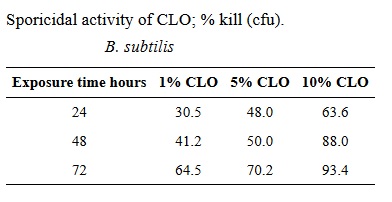
APCLO
Bactericidal: "The 7 bacteria consisted of three Gram-positive organisms, Bacillus subtilis, Streptococcus pyogenes, and Enterococcus fecalis, and four Gram-negative organisms, Acinetobacter baumannii, Hemophilus influenzae, Salmonella enteritidis, and Escherichia coli. They were all readily killed by CLO, although their relative sensitivities were somewhat different. These activities were bactericidal rather than bacteriostatic. Purified spores of Bacillus subtilis were also sensitive to CLO, but they were relatively resistant in comparison to the corresponding vegetative (growing) cells. In general bacterial spores were found to be much more resistant than vegetative cells to a variety of antibacterial agents and disinfectants [10,25]." APCLO
"B. subtilis was readily killed by CLO after several minutes contact with the oil. Concentrations of CLO down to 0.1% (in saline) completely killed the bacteria within one hour. Further dilutions showed successively less efficacy." APCLO
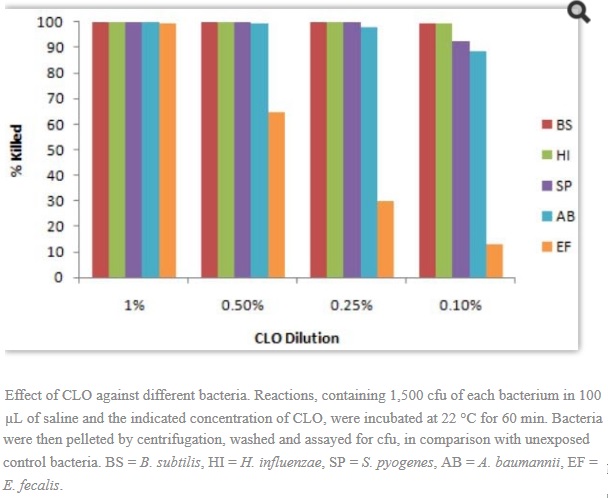 APCLO APCLO |
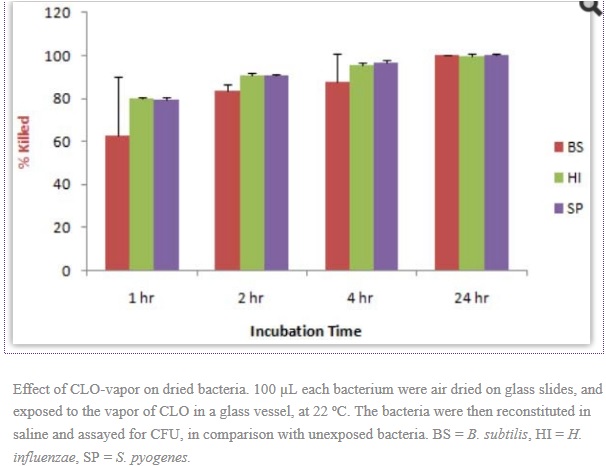 APCLO APCLO
|
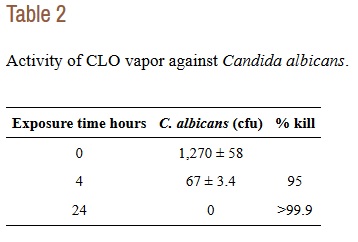
APCLO
Fungicidal?: "Two fungi, the medically important yeast Candida albicans, and the filamentous mold Aspergillus niger, and were also readily inactivated by CLO. C. albicans was as sensitive as the more sensitive bacteria, although the A. niger appeared to recover to some degree after several days of incubation. Further studies are required to determine if the activity against A. niger is fungicidal or fungistatic. However even if CLO cannot completely eradicate the fungus, its ability to curtail fungal growth would still be beneficial." APCLO
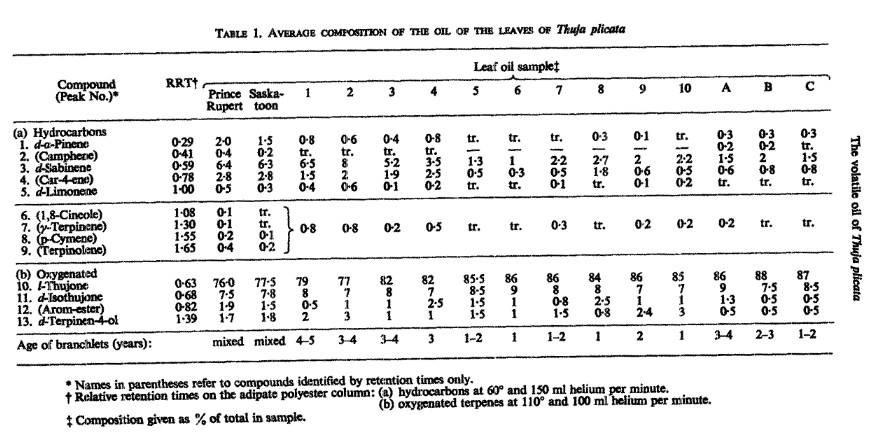
[VOTP]
Thujone
There was some variation in the concentration of thujone in western red cedar needles, but it did not correlate with the height in the tree and was more likely to be due to biological variation in the needles. alpha-Thujone is by far the most common terpene in western red cedar (von Rudloff & Lapp, 1979; von Rudloff et al., 1988). [TSTP]
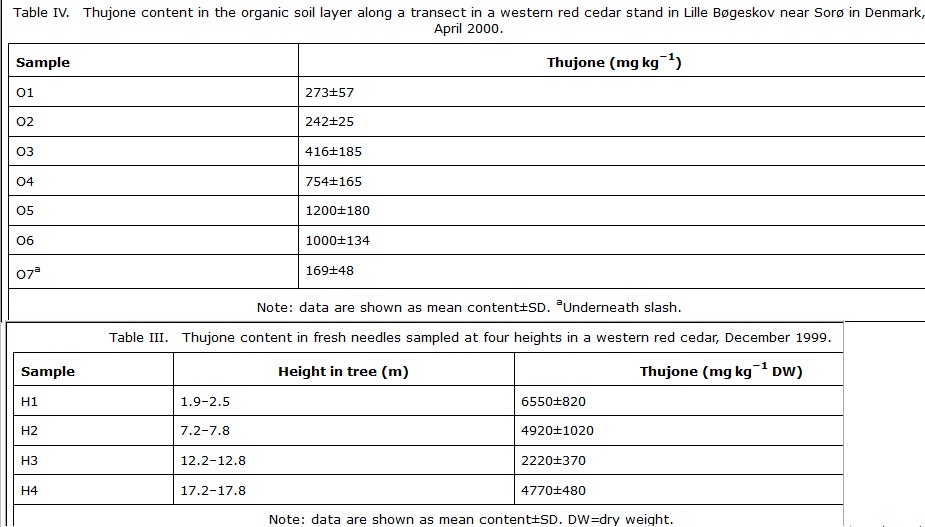
[TSTP]
Norditerpene alcohols

[NorAlc]
Propagation
"Seed - best sown when ripe in the autumn in a cold frame(113). Stored seed germinates best if given a short cold stratification(113). It can be sown in a cold
frame in late winter. When they are large enough to handle, prick the seedlings out into individual pots and grow them on in the greenhouse for their first winter.
Plant them out into their permanent positions in late spring or early summer, after the last expected frosts. If growing large quantities of plants, the seed can
be sown in an outdoor seed bed in mid spring(78). Grow the plants on for two years and then plant them out into their permanent positions in late autumn or early
spring. Cuttings of half-ripe wood, 5 - 8cm with a heel, July/August in a shaded frame. Forms roots by the end of September but it should be overwintered in a
frame(78). Cuttings of almost ripe wood, 5 - 10cm with a heel, September in a cold frame. Forms roots in the following summer. Plant out in autumn or
spring(78)." [PFAF]
Cultivation
"Landscape Uses: Pest tolerant, Screen, Specimen. Prefers a moist loamy soil(1, 81). Dislikes dry soils(11). Not suitable for light sandy soils because it is
shallow rooting(75), but it succeeds on most other soil types, even on waterlogged soils and heavy clays(81, 200). Succeeds in chalky soils(200). Prefers some
shelter from the wind according to some reports(1, 81) whilst others say that it is fairly wind resistant(11, 75). Trees tolerate salt winds(75) but not severe
maritime exposure(K). The wood and foliage are highly aromatic(226). The foliage has a strong fruity smell, like pear-drops or crushed apples(185). A fast growing
tree, it often puts out new growth of 1 metre a year and can average 60cm a year for the first 40 years. Increase in girth can also be rapid, 5cm a year for the
first 60 years has been recorded(185). Sometimes planted for forestry in Britain(17), it is at its best in the moister western half of the country(11, 185).
There are many named varieties selected for their ornamental value(188). Tolerant of light trimming, so long as this is not back into old wood, plants also
retain their lower branches unless these are shaded out by neighbouring plants(11). The foliage turns bronze in cold weather(81). Trees are notably susceptible
to honey fungus(81, 200). Special Features: North American native, Inconspicuous flowers or blooms." [PFAF]
"Shelterbelt: Tolerant of light trimming and of reasonable exposure, this species can be grown as a hedge or as part of a shelterbelt(75)" [PFAF]
Effects on Environment:
Richardson, Shaughnessy, and Harrison (2004) found higher densities of detritivores in western red cedar litter in a forest stream than with western hemlock (Tsuga heterophylla Sargent).[TSTP]
The low decomposition rates of western red cedar litter observed both on the forest floor and in forest streams are likely to be due to high contents of lignin (Prescott et al., 2004; Richardson et al., 2004).[TSTP]
Synonyms
- T. gigantea. T. lobbii. T. menziesii. [PFAF]
- ACD Allergic contact dermatitis from cedar wood (Thuja plicata) E. BLEUMINK, J. C. MITCHELL and J. P. NATER, British Journal of Dermatology Volume 88, Issue 5, pages 499–504, May 1973
- APCLO The Antimicrobial Properties of Cedar Leaf (Thuja plicata) Oil; A Safe and Efficient Decontamination Agent for Buildings, James Hudson, Michael Kuo, and Selvarani Vimalanathan, International journal of environmental research and public health, 12/2011, Volume 8, Issue 12
- [E-flora] Thuja plicata, E-Flora BC: Electronic Atlas of the Flora of British Columbia [eflora.bc.ca]., linnet.geog.ubc.ca/Atlas/Atlas.aspx?sciname=Thuja plicata&redblue=Both&lifeform=1[Accessed: 11/26/2014 7:16:12 PM ]
- [NorAlc] Norditerpene alcohols in the bark of Thuja plicata Donn H. H. Quon, Eric P. Swan, Canadian Journal of Chemistry, 1969, 47(23)
- [PFAF] Thuja plicata, http://www.pfaf.org/user/Plant.aspx?LatinName=Thuja+plicata, Plants For A Future, Accessed Jan 17, 2015
- [TSTP] Thujone in soil under Thuja plicata, Bjarne W. Strobel, Pia H. Jensen, Lars H. Rasmussen & Hans Christian B. Hansen, Scandinavian Journal of Forest Research, Volume 20, Issue 1, 2005
- [VOTP] Gas—liquid chromatography of terpenes VI. The volatile oil of Thuja plicata Donn, E. von Rudloff, Phytochemistry Volume 1, Issue 3, September 1962, Pages 195–202